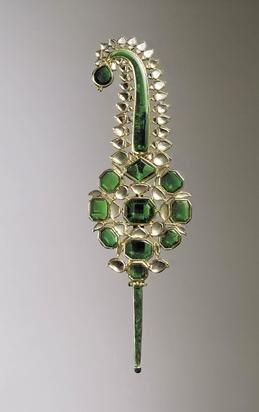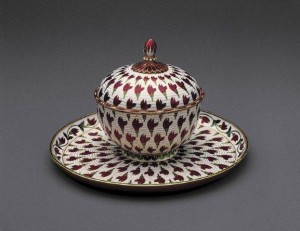 It was news last fall when the  Museum of Fine Arts in Houston announced a five-year partnership with Sheikh Nasser Sabah al-Ahmed al-Sabah and his wife, Sheikha Hussah Sabah al-Salem al-Sabah, of Kuwait — through which the al-Sabahs would send parts of their collection for long-term viewing in Houston. They want their treasures seen around the world, as a means of expanding the view people have of Muslims to include its culture. Given so many political ties in Texas (the Sheikha visited George H.W. Bush last week), and with its oil companies, it was natural for the family to choose the MFAH (though having Mahrukh Tarapor, formerly with the Metropolitan Museum and now senior adviser for international initiatives to the MFAH, must have helped).
It was news last fall when the  Museum of Fine Arts in Houston announced a five-year partnership with Sheikh Nasser Sabah al-Ahmed al-Sabah and his wife, Sheikha Hussah Sabah al-Salem al-Sabah, of Kuwait — through which the al-Sabahs would send parts of their collection for long-term viewing in Houston. They want their treasures seen around the world, as a means of expanding the view people have of Muslims to include its culture. Given so many political ties in Texas (the Sheikha visited George H.W. Bush last week), and with its oil companies, it was natural for the family to choose the MFAH (though having Mahrukh Tarapor, formerly with the Metropolitan Museum and now senior adviser for international initiatives to the MFAH, must have helped).
So the other night, the MHAF unveiled its entry in the Islamic race: a gallery filled with about 70 objects on loan from the al-Sabahs. It can’t compare in volume with the Met’s newish Islamic wing, which attracted more than 1 million visitors in not much more than a year, or with the Louvre’s new wing for Islamic art — topped by that golden “flying carpet” — but still. Apparently what the Kuwaitis sent is choice. The museum’s description:
Among the highlights showcased in this display are spectacular Mughal jewelry, illuminated manuscripts, exquisite ceramics, and intricately decorated ceiling panels. More than 60 examples from the 8th to 18th centuries are on view, made in the Iberian Peninsula, North Africa, the Middle East, and Central Asia. The collection also includes carpets, glass and metalwork, paintings, architectural fragments, scientific instruments, and works on paper.
And there’s much more where that came from, and the Kuwaiti News Agency is out with an article that says that there will be more international sharing of the 30,000 works in the collection (which is on permanent loan to the state of Kuwait).
 But not with U.S. museums — even though its clear that the public has an appetite for art of the Muslim world.
But not with U.S. museums — even though its clear that the public has an appetite for art of the Muslim world.
Houston’s renewable deal is exclusive in the U.S., the KNA said. Rather, it added, “plans are underway to potentially launch exhibitions in Italy, Finland, South Korea and Singapore, where there are few Islamic art collections available to the public.” KNA did not name the institutions involved, but it provided a lot more background on Kuwaiti thinking.
Among American museums, the other good places to see respected collections of Islamic art are the Detroit Institute of Arts, the Freer-Sackler in Washington and the Los Angeles Country Museum of Art.
The current al-Sabah selection is expected to remain in Houston for about a year; then, there will be a switch-out.
Photo Credit: Two 17th century pieces from India, courtesy of the MHAF
